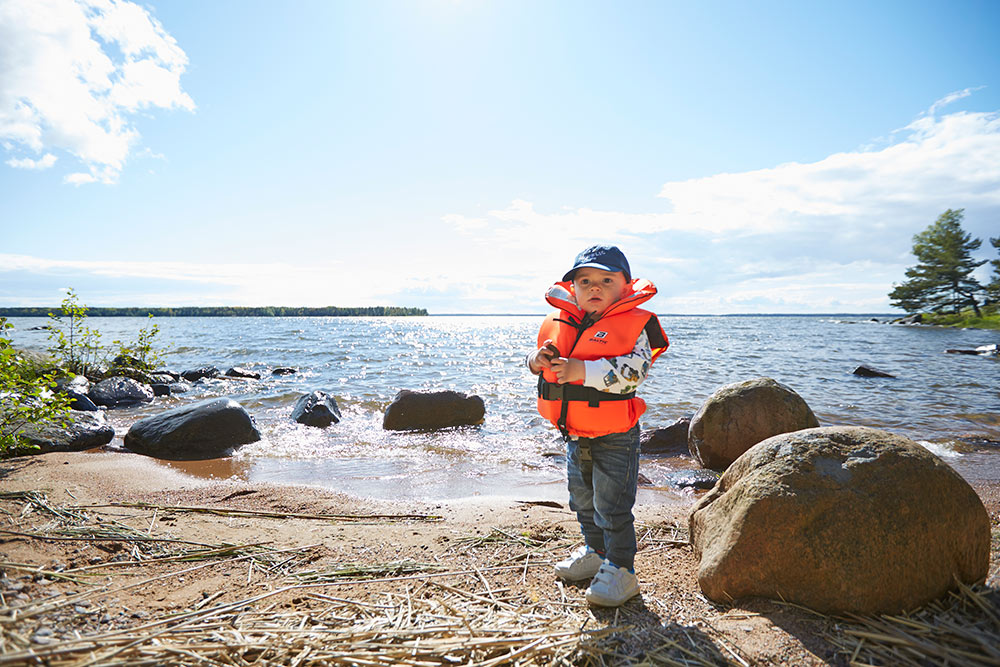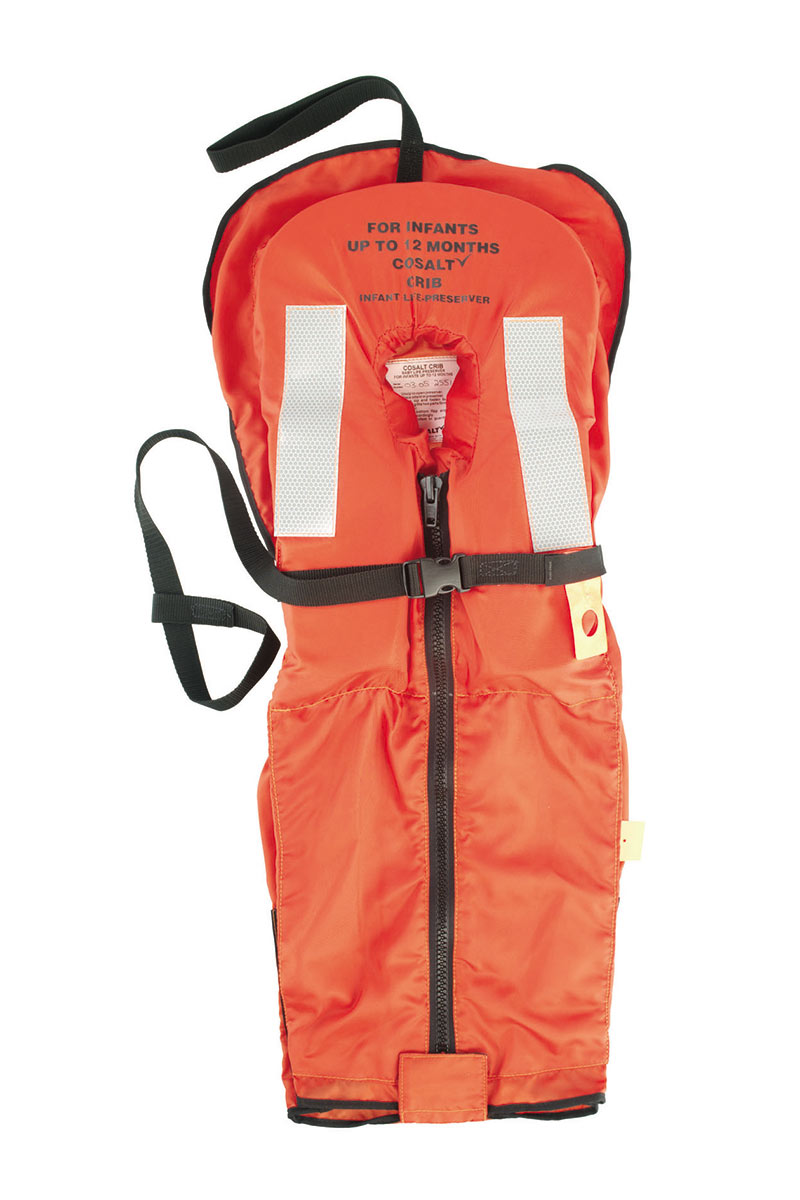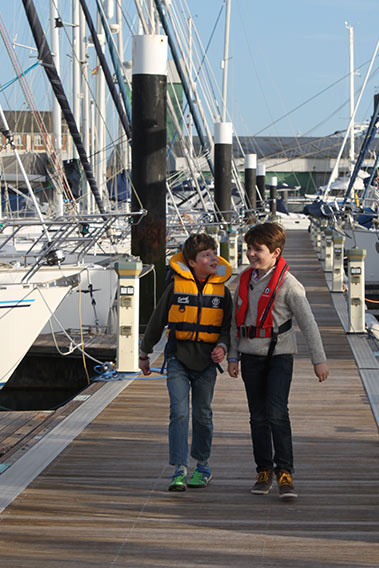Lifejackets for children: a buyer’s guide
Are you trying to buy lifejackets for children? In this in-depth guide to kid’s lifejackets, you’ll learn what to look for when shopping for a junior lifejacket and how to buy one your children will actually wear!
Whether you’re trying to get your kids into dinghy sailing, you’re considering the liveaboard lifestyle, or you’re just heading out for a day on the water with friends, buying a children’s lifejacket should be your first priority. And if you’re the parent of an avid boating youngster, you might even be in the market for new PFDs (personal floatation devices, such as lifejackets and other buoyancy aids) more frequently than you (or your budget) might like!
But getting the right lifejacket for children is essential. And it’s important to recognise that, even if last season’s lifejacket might look like it still fits, if your child’s chest size or body weight exceeds the guidelines, the device’s effectiveness in the water could quickly become compromised.

Baltic split front lifejacket for children. The Swedish company has a wide and colourful choice of different styles and fits.
In This Article:
- The Difference Between Buoyancy Aids and Lifejackets
- What is Buoyancy?
- Children's Buoyancy
- Children's Lifejackets
- Children's Inflatable Lifejackets
- Children's Buoyancy Aids
- ISO 12402 Explained
- Related Reading
The difference between buoyancy aids and lifejackets
If you’re looking for your first children’s lifejacket, you might notice that sometimes they’re called “lifejackets”, and other times they’re listed as “children’s buoyancy aids”. But are these two words for the same thing? Or do you need to know the difference?
Buoyancy aids are vests worn by jetskiers, dinghy sailors, kayakers, and numerous other active water users. A buoyancy aid will generally be worn over a wetsuit or drysuit, enabling the wearer to swim comfortably should they fall into the water.
Lifejackets are designed more for non-swimmers or anyone on a boat that is not suitably dressed for sudden, total immersion. One of the key dangers in the UK when falling overboard is cold water shock, which can trigger a gasp reflex, causing inhalation of water and inability to circulate the blood to the legs and arms. This can disable even the most confident swimmers and impair their ability to self-rescue.
Lifejackets are designed to roll the wearer onto his or her back and support the head above the water. It is difficult to swim or do anything much when wearing a lifejacket, but it will keep your head above water and give you a chance to catch your breath if you’ve taken a sudden, unexpected dip.
What is buoyancy?
All new lifejackets and buoyancy aids sold in the UK, Republic of Ireland and elsewhere in Europe must meet the International Standards Organisation standard ISO12402 (more on this at the end of the article). You may still find older lifejackets on the market that carry the CE mark, which is numbered from EN393 to EN399, depending on the amount of buoyancy (floatation) provided.
In addition to certifications, floatation devices are also rated in Newtons, which tells the shopper how much buoyancy they can expect from the device. Standard buoyancy aids are generally rated around 50N, while lifejackets are rated from 100N to 275N.
According to the RNLI, there are four standard levels of buoyancy aids to consider:
Buoyancy aid level 50
Level 50 buoyancy aids are recommended for swimmers in sheltered waters or while doing watersports when help is close at hand. They should only be used by those who can already swim and are comfortable in the water, as they do not offer sufficient buoyancy to keep someone afloat if they can’t help themselves, nor are they designed to turn a person around if lying face-down in the water.
Lifejacket level 100
At level 100, lifejackets can be used in calm and sheltered water. They will offer more buoyancy than a standard aid but should still not be used for anyone who can’t swim at all and may not have enough buoyancy to roll an unconscious person onto their back.
Lifejacket level 150
At 150N, lifejackets can be used on coastal and offshore waters where they need to work a bit harder to stay afloat. A 150N lifejacket is capable of rolling an unconscious person onto their back and can keep the wearer’s head out of the water even with no assistance from the person. However, the effectiveness of this type of lifejacket can vary depending on the clothing being worn beneath it - for eg, it will be less effective if the user is wearing heavy and/or waterproof clothing.
Lifejacket level 275
This is the most intense style of lifejacket and is intended for offshore use, extreme conditions, and for heavy protective clothing that might adversely affect the self-righting capacities of lesser lifejackets. With this jacket, even if you’re wearing heavy clothes, are unconscious, or simply can’t swim at all, the lifejacket will be able to turn the wearer onto their back and keep them afloat with their nose out of the water.
Children’s buoyancy
However, junior-sized buoyancy aids - despite still being categorised as 50N - may only provide 35N or 40N. This is because 35N of buoyancy on a child that weighs just 40kg would be proportionately similar to the effect of a 50N floatation aid on an 85kg adult. So, the appropriate buoyancy level for a lifejacket can vary depending on the size and weight of the person/child wearing it.
Similarly, lifejackets for babies or toddlers might contain even fewer Newtons, but they would still be rated at 100N or 150N, even if they actually contain as little as 30N of buoyancy.
Usually, solid lifejackets get their floatation capabilities from foam packed inside the outer material. While this is incredibly effective, it can also restrict movement in the water, meaning you’re not going to be swimming laps while wearing a standard foam lifejacket.
Children’s lifejackets
Foam lifejackets are the only flotation devices available for children until they’re at least seven. However, many would recommend children exclusively wear lifejackets until the age of eight or nine years old.
As explained above, typically, the smallest, 100N “baby” jackets will provide 30N of buoyancy, rising to 50N for junior lifejackets and 80N for medium-sized adults/teens. Some will come with a whistle, and designers now include attractive print elements on the outer fabric to make them more attractive for younger wearers. Still, there are generally few other added extras when shopping for kid’s lifejackets.
“The most important thing is fit”, says Louise Crowden, UK representative of Swedish manufacturer Baltic. “If they’re not comfortable, the children won’t wear [their lifejacket]. The best way to get them to fit is to try it on and make sure it’s not going to swamp or ride up the child. If the jacket is too bulky, they won’t want to wear them when they’re out and about playing.”

At the time of writing (October 2024), Baltic supplies eight different 100N children’s lifejackets. These can be shopped by weight, with the Skipper Lifejacket* offering six kid’s sizes: 3-10kg (baby), 10-20kg (barn), 15-30kg (barn), 30-40kg (junior), 40-50kg (junior), as well as three adult sizes: 50-70kg (M), 70-100kg (L), and 100+kg (XL).
*This children’s life jacket is mentioned here as an example and in no way should be interpreted as a recommendation to buy. Shoppers should always do their own research and select the lifejacket that is best for them and/or their children and their specific circumstances. Most lifejacket retailers will be happy to help if you have further questions or are unsure which junior buoyancy aid to purchase.
“Obviously, 150N is quite a lot of foam to encourage a child to wear,” says Crewsaver spokesperson Hannah Burywood. “But if you are going to the Isle of Wight or France, you do really want the extra 50N just to make sure the head is nice and clear of the water and that they spin round nice and quickly. A 100N jacket is more suitable for a sort of splash around at the sailing club off the pontoons type of environment.”
Children’s inflatable lifejackets
The market for children’s inflatable lifejackets is relatively small (no pun intended) but for confident, strong youngsters, escaping the bulk of the foam lifejacket can be very encouraging.
Instead of being packed with foam, an inflatable lifejacket will fill with air upon contact with the water. This means that kids can run around comfortably while ashore, with their parents happy that, should they take an unexpected dip, their lifejacket will engage and they will be able to float safely.
Although there’s a limited market for this type of lifejacket, parents of children who can already swim and are confident in the water do have a few options… Crewsaver offers the Crewfit 150N Junior, Ocean Safety offers the Kru Junior (for older kids), and Spinlock has the 150N Deckvest Cento Junior, rated for children from 20–50kg. All three come with integral harnesses and crotch straps, but other accessories, such as lights and AIS device slots, are extras and not always available.
“When considering a junior inflatable jacket, age and competence need to be taken into account,” says Hannah Burywood. “You want to make sure they understand the lifejacket they’re wearing and that if they do fall in, it’s going to inflate, etc. But, of course, [an inflatable lifejacket] a lot less restrictive than foam and a lot more encouraging to wear.”

The Spinlock Deckvest Cento was launched in March 2015 and is suitable for a wide range of children from 20–50kg in weight.
Automatic inflation is fitted as standard in all children’s inflatable lifejackets, but manual inflation options can also be available. James Hall from Spinlock advises looking online for demonstration videos of lifejackets inflating or just organising a trial in the water so the child will know what to expect in case of going overboard.
Children’s buoyancy aids
For juniors, there are many advantages to wearing a buoyancy aid: they are cheaper and easier to put on and take off and much more comfortable to wear than 100N foam jackets. Wearers can comfortably swim and be active – wet or dry. The jackets are easily adjustable and feature crotch straps to prevent them from riding up.
Henri Lloyd offers buoyancy aids for ages 6–8, but in general, the smallest size buoyancy aids on sale in the UK are suitable for children between 9 and 10 years old with a chest circumference of around 80cm and weighing 30–40kg. They will all be rated 50N but, as explained above, jackets designed for small, light children will contain less foam than adult jackets.
Again, fit is the most important aspect – to ensure children are happy to wear them at all times and that they can do their job in the water rather than just slip off. Other features include side zips, neoprene shoulder straps, and pockets, all adding to the wearer’s experience.
ISO 12402 explained
(By the product development team at Gill) (Later updated by Pippa Shaw in October 2024)
The original ISO 12402 was published in 2006. Since then, there have been several amendments to the regulations. The current version in British law is the BS EN ISO 12402‑5:2020, which is the UK’s post-Brexit implementation of the EN ISO 12402‑5:2020 and is identical to the ISO 12402‑5:2020. This edition was published in 2020.
This regulation covers various aspects that manufacturers must adhere to when developing personal floatation devices, and includes the following parts:
- Part 2: Lifejackets, performance level 275 — Safety requirements
- Part 3: Lifejackets, performance level 150 — Safety requirements
- Part 4: Lifejackets, performance level 100 — Safety requirements
- Part 5: Buoyancy aids (level 50) — Safety requirements
- Part 6: Special purpose lifejackets and buoyancy aids — Safety requirements and additional test methods
- Part 7: Materials and components — Safety requirements and test methods
- Part 8: Accessories — Safety requirements and test methods
- Part 9: Test methods
What is the standard?
The standard sets out the minimum performance criteria for all levels of Personal Flotation Devices (PFD), the materials and components incorporated into PFDs, and the test methods used. ISO 12402 has ten parts relating to the full range of PFDs and different performance levels from shipping to junior watersports.
Is this an improvement on the old standard?
All standards are reviewed every five years. The ISO standard was brought in to harmonise the lifejacket standards, and it moved from an EN standard to an ISO standard, meaning member states outside of Europe also adopted it. This has been done in the UK with our “British Standard” version of the legislation, broken down as follows:
BS (British Standard) EN (European Nation) ISO 12402‑5:2020
So, you can see how we’ve implemented the EN standard into British law.
What was it before?
Before we got the ISO standards, the rules regulating the performance and use of personal flotation devices were called the EN suite of standards: EN 393, EN 394, EN 396, EN 399.
What’s different between junior and adult PFDs?
The required amount of buoyancy, measured in Newtons, is lower for Child and Youth PFDs – 35N & 40N, respectively. This accounts for lower body mass and helps reduce the amount of buoyant foam required – thereby reducing bulk and improving fit for slimmer torsos.
Related Reading
If you want to make the most out of time with your children, why not check out some of our other articles about boating with kids and staying safe on the water?
- A Buyer’s Guide to Lifejackets and Buoyancy Aids
- 5 tips for fun family boating trips
- How to start your kids dinghy sailing
- How to get your family boating
- What safety equipment do I need on my boat?
Editors Note: This article was originally written and published by Rob Melotti in July 2018, updated by Pippa Shaw April 2025.
















